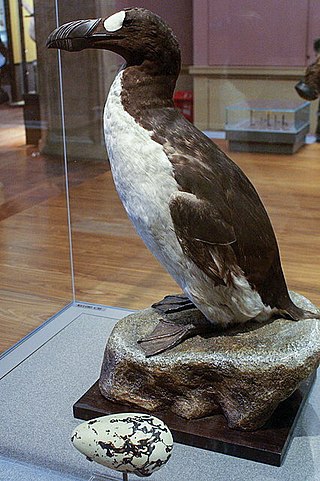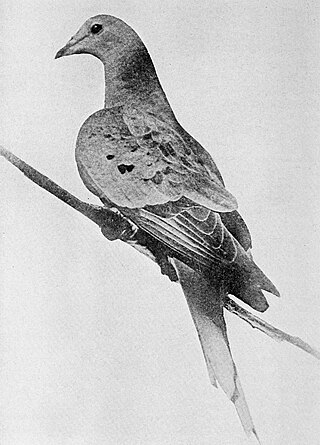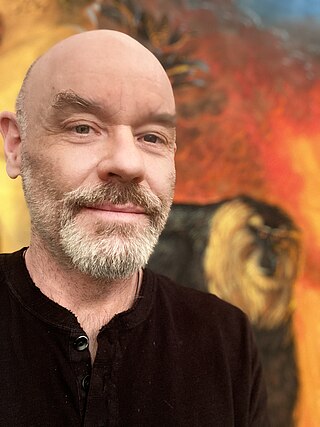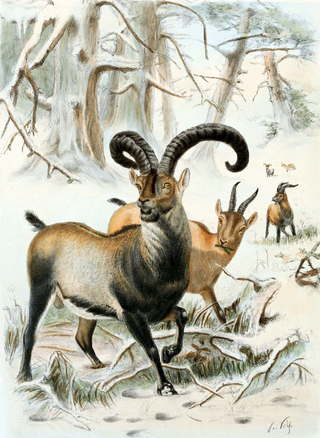
The Carolina parakeet, or Carolina conure, is an extinct species of small green neotropical parrot with a bright yellow head, reddish orange face, and pale beak that was native to the Eastern, Midwest, and Plains states of the United States. It was the only indigenous parrot within its range, as well as one of only three parrot species native to the United States. It was called puzzi la née or pot pot chee by the Seminole and kelinky in Chickasaw. Though formerly prevalent within its range, the bird had become rare by the middle of the 19th century. The last confirmed sighting in the wild was of the C. c. ludovicianus subspecies in 1910. The last known specimen, a male named Incas, perished in captivity at the Cincinnati Zoo in 1918, and the species was declared extinct in 1939.

The great auk is a species of flightless alcid that became extinct in the mid-19th century. It was the only modern species in the genus Pinguinus. It is not closely related to the Southern Hemisphere birds now known as penguins, which were discovered later by Europeans and so named by sailors because of their physical resemblance to the great auk, which were called penguins.

The passenger pigeon or wild pigeon is an extinct species of pigeon that was endemic to North America. Its common name is derived from the French word passager, meaning "passing by", due to the migratory habits of the species. The scientific name also refers to its migratory characteristics. The morphologically similar mourning dove was long thought to be its closest relative, and the two were at times confused, but genetic analysis has shown that the genus Patagioenas is more closely related to it than the Zenaida doves.

Columbidae is a bird family consisting of doves and pigeons. It is the only family in the order Columbiformes. These are stout-bodied birds with short necks and short slender bills that in some species feature fleshy ceres. They primarily feed on plants, and can be taxonomically divided amongst granivores, that feed mostly on the ground on seeds, and frugivores, that feed mostly on fruits, from branches. The family occurs worldwide, often in close proximity with humans, but the greatest variety is in the Indomalayan and Australasian realms.

The Anatidae are the biological family of water birds that includes ducks, geese, and swans. The family has a cosmopolitan distribution, occurring on all the world's continents except Antarctica. These birds are adapted for swimming, floating on the water surface, and in some cases diving in at least shallow water. The family contains around 174 species in 43 genera.

The North Carolina Zoo is a zoo in Asheboro, North Carolina, housing 1,700 animals of more than 250 species, primarily representing Africa and North America. It is one of two state-supported zoos in the United States, with the other being the Minnesota Zoo. With 500 acres (2.0 km2) developed, it is the world's largest natural habitat zoo. The North Carolina Zoo is a part of the North Carolina Department of Natural and Cultural Resources.

Martha was the last known living passenger pigeon ; she was named "Martha" in honor of the first First Lady Martha Washington.

The Rodrigues parrot or Leguat's parrot is an extinct species of parrot that was endemic to the Mascarene island of Rodrigues. The species is known from subfossil bones and from mentions in contemporary accounts. It is unclear to which other species it is most closely related, but it is classified as a member of the tribe Psittaculini, along with other Mascarene parrots. The Rodrigues parrot bore similarities to the broad-billed parrot of Mauritius, and may have been related. Two additional species have been assigned to its genus, based on descriptions of parrots from the other Mascarene islands, but their identities and validity have been debated.

Walton Ford is an American artist who makes paintings and prints in the style of naturalist illustrations, often depicting extinct species. Each of his paintings is a meticulous, realistic study in flora and fauna, and is filled with symbols, clues, and jokes referencing texts ranging from colonial literature, to folktales, to travel guides. The paintings are complex allegorical narratives that critique the history of colonialism, industrialism, politics, natural science, and humanity's effect on the environment.

Bird extinction is the complete elimination of all species members under the taxonomic class, Aves. Out of all known bird species,, 159 (1.4%) have become extinct, with 226 (2%) being critically endangered. There is a general consensus among ornithologists that if anthropogenic activities continue as current trends suggest, one-third of all bird species, and an even greater proportion of bird populations, will be rendered extinct by the end of the 21st century.

Errol Fuller is an English writer and artist who lives in Tunbridge Wells, Kent. He was born in Blackpool, Lancashire, grew up in South London, and was educated at Addey and Stanhope School. He is the author of a series of books on extinction and extinct creatures.

The Mascarene grey parakeet, Mauritius grey parrot, or Thirioux's grey parrot, is an extinct species of parrot which was endemic to the Mascarene Islands of Mauritius and Réunion in the western Indian Ocean. It has been classified as a member of the tribe Psittaculini, along with other parrots from the Islands.

De-extinction is the process of generating an organism that either resembles or is an extinct species. There are several ways to carry out the process of de-extinction. Cloning is the most widely proposed method, although genome editing and selective breeding have also been considered. Similar techniques have been applied to certain endangered species, in hopes to boost their genetic diversity. The only method of the three that would provide an animal with the same genetic identity is cloning. There are benefits and drawbacks to the process of de-extinction ranging from technological advancements to ethical issues.
Carl Gwynfe Jones, MBE is a Welsh conservation biologist, who has been employed by Durrell Wildlife Conservation Trust since 1985, and a founding member (1984) and current scientific director of Mauritian Wildlife Foundation (MWF). Additionally he is Chief Scientist at Durrell Wildlife Conservation Trust, and an honorary professor in ecology and conservation biology at the University of East Anglia. Often outspoken on the importance of knowing your species and using intuition, empathy and practical knowledge over dogmatic education, Jones is best known for his work in recovering the Mauritius kestrel from just four individuals in 1974, to an estimated 400. Working in the Mascarene Islands since 1979, Jones has led five successful bird restoration projects where the starting population has numbered less than 12 individuals; as a consequence Mauritius has averted more bird extinctions than any other country. Jones has pioneered the use of ecological or taxon replacements to fill the ecological roles of extinct animals and successfully restored levels of endemic vegetation to previously denuded islets. Jones' work has been highlighted in Douglas Adams and Mark Carwardine's 1990 radio documentary Last Chance to See, along with its accompanying book, as well as David Quammen's 1996 book The Song of the Dodo: Island Biogeography in an Age of Extinctions.

Thomas Jefferson is a 1911 bronze statue of a seated Thomas Jefferson created by Karl Bitter for the Cuyahoga County Courthouse in Cleveland, Ohio, United States.
Elephant Path: Njaia Njoku, is a 2018 Central African documentary film directed by Todd McGrain and co-produced by McGrain and Scott Anger. The film revolves around an unlikely alliance made by an American biologist, a Bayaka tracker, a Bantu eco-guard, and an Israeli security contractor where they started to protect the last wild herd of forest elephants of Central African Republic.

Incas was a male Carolina parakeet and the last member of his species known with certainty. Though probable sightings of wild Carolina parakeets continued into the 1930s, and the American Ornithologists Union accepted a sighting in 1920, no specimens were collected after 1904 and he is often cited as the last individual in existence. Incas died in the Cincinnati Zoo in 1918, in the same enclosure as Martha, the last passenger pigeon, who died in 1914. He died within one year of his mate, Lady Jane.














